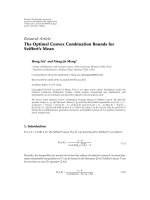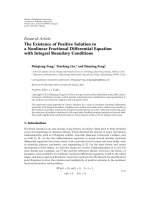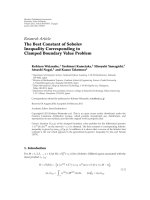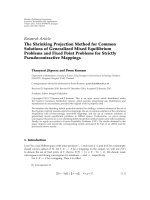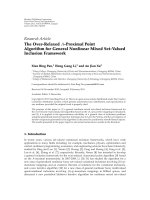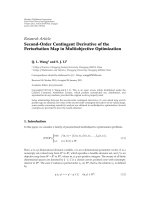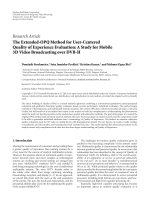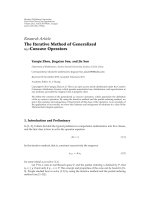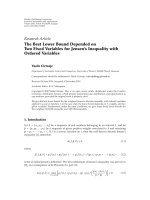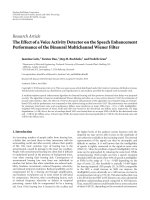Báo cáo hóa học: " Research Article The Schur Harmonic Convexity of the Hamy Symmetric Function and Its Applications" pptx
Bạn đang xem bản rút gọn của tài liệu. Xem và tải ngay bản đầy đủ của tài liệu tại đây (491.88 KB, 10 trang )
Hindawi Publishing Corporation
Journal of Inequalities and Applications
Volume 2009, Article ID 838529, 10 pages
doi:10.1155/2009/838529
Research Article
The Schur Harmonic Convexity of the Hamy
Symmetric Function and Its Applications
Yuming Chu and Yupei Lv
Department of Mathematics, Huzhou Teachers College, Huzhou 313000, China
Correspondence should be addressed to Yuming Chu,
Received 2 April 2009; Accepted 20 May 2009
Recommended by A. Laforgia
We prove that the Hamy symmetric function F
n
x, r
1≤i
1
<i
2
<···<i
r
≤n
r
j1
x
i
j
1/r
is Schur
harmonic convex for x ∈ R
n
. As its applications, some analytic inequalities including the well-
known Weierstrass inequalities are obtained.
Copyright q 2009 Y. Chu and Y. Lv. This is an open access article distributed under the Creative
Commons Attribution License, which permits unrestricted use, distribution, and reproduction in
any medium, provided the original work is properly cited.
1. Introduction
Throughout this paper we use R
n
to denote the n-dimensional Euclidean space over the field
of real numbers, and R
n
{x x
1
,x
2
, ,x
n
∈ R
n
: x
i
> 0,i 1, 2, ,n} .
For x x
1
,x
2
, ,x
n
, y y
1
,y
2
, ,y
n
∈ R
n
and α>0, we denote by
x y
x
1
y
1
,x
2
y
2
, ,x
n
y
n
,
xy
x
1
y
1
,x
2
y
2
, ,x
n
y
n
,
αx
αx
1
,αx
2
, ,αx
n
1
x
1
x
1
,
1
x
2
, ,
1
x
n
.
1.1
For x x
1
,x
2
, ,x
n
∈ R
n
, the Hamy symmetric function 1–3 was defined as
F
n
x, r
F
n
x
1
,x
2
, ,x
n
; r
1≤i
1
<i
2
<···<i
r
≤n
⎛
⎝
r
j1
x
i
j
⎞
⎠
1/r
,r 1, 2, ,n.
1.2
2 Journal of Inequalities and Applications
Corresponding to this is the rth order Hamy mean
σ
n
x, r
σ
n
x
1
,x
2
, ,x
n
; r
1
n
r
F
n
x, r
, 1.3
where
n
r
n!/n −r!r!. Hara et al. 1 established the following refinement of the classical
arithmetic and geometric means inequality:
G
n
x
σ
n
x, n
≤ σ
n
x, n − 1
≤···≤σ
n
x, 2
≤ σ
n
x, 1
A
n
x
. 1.4
Here A
n
x1/n
n
i1
x
i
and G
n
x
n
i1
x
i
1/n
denote the classical arithmetic and
geometric means, respectively.
The paper 4 by Ku et al. contains some interesting inequalities including the fact that
σ
n
x, r
r
is log-concave, the more results can also be found in the book 5 by Bullen. In 2,
the Schur convexity of Hamy’s symmetric function and its generalization were discussed. In
3 , Jiang defined the dual form of the Hamy symmetric function as follows:
H
∗
n
x, r
1≤i
1
<i
2
<···<i
r
≤n
⎛
⎝
r
j1
x
i
j
1/r
⎞
⎠
,r 1, 2, ,n, 1.5
discussed the Schur concavity Schur convexity of H
∗
n
x, r, and established some analytic
inequalities.
The main purpose of this paper is to investigate the Schur harmonic convexity of
the Hamy symmetric function F
n
x, r. Some analytic inequalities including Weierstrass
inequalities are established.
2. Definitions and Lemmas
Schur convexity was introduced by Schur in 1923 6, and it has many important applications
in analytic inequalities 7–12, linear regression 13, graphs and matrices 14, combinatorial
optimization 15, information-theoretic topics 16, Gamma functions 17, stochastic
orderings 18, reliability 19, and other related fields.
For convenience of readers, we recall some definitions as follows.
Definition 2.1. AsetE
1
⊆ R
n
is called a convex set if x y/2 ∈ E
1
whenever x, y ∈ E
1
.Aset
E
2
⊆ R
n
is called a harmonic convex set if 2xy/x y ∈ E
2
whenever x, y ∈ E
2
.
It is easy to see that E ⊆ R
n
is a harmonic convex set if and only if 1/E {1/x : x ∈ E}
is a convex set.
Definition 2.2. Let E ⊆ R
n
be a convex set a function f : E → R
1
is said to be convex on E if
fx y/2 ≤ fxfy/2 for all x, y ∈ E. Moreover, f is called a concave function if −f
is a convex function.
Journal of Inequalities and Applications 3
Definition 2.3. Let E ⊆ R
n
be a harmonic convex set a function f : E → R
1
is called a harmonic
convex or concave, resp. function on E if f2xy/x y ≤ or ≥ resp. 2fxfy/fx
fy for all x, y ∈ E.
Definitions 2.2 and 2.3 have the following consequences.
Fact A. If E
1
⊆ R
n
is a harmonic convex set and f : E
1
→ R
1
is a harmonic convex function,
then
F
x
1
f
1/x
:
1
E
1
−→ R
1
2.1
is a concave function. Conversely, if E
2
⊆ R
n
is a convex set and F : E
2
→ R
1
is a convex
function, then
f
x
1
F
1/x
:
1
E
2
−→ R
1
2.2
is a harmonic concave function.
Definition 2.4. Let E ⊆ R
n
beasetafunctionF : E → R
1
is called a Schur convex function on
E if
F
x
1
,x
2
, ,x
n
≤ F
y
1
,y
2
, ,y
n
2.3
for each pair of n-tuples x x
1
,x
2
, ,x
n
and y y
1
,y
2
, ,y
n
in E, such that x ≺ y,that
is,
k
i1
x
i
≤
k
i1
y
i
,k 1, 2, ,n− 1,
n
i1
x
i
n
i1
y
i
,
2.4
where x
i
denotes the ith largest component in x. F is called a Schur concave function on E
if −F is a Schur convex function on E .
Definition 2.5. Let E ⊆ R
n
beasetafunctionF : E → R
1
is called a Schur harmonic convex
or concave, resp. function on E if
F
1
x
1
,
1
x
2
, ,
1
x
n
≤
or ≥ resp.
F
1
y
1
,
1
y
2
, ,
1
y
n
2.5
for each pair of x x
1
,x
2
, ,x
n
and y y
1
,y
2
, ,y
n
in E, such that x ≺ y.
Definitions 2.4 and 2.5 have the following consequences.
4 Journal of Inequalities and Applications
Fact B. Let E ⊆ R
n
be a set, and H 1/E {1/x : x ∈ E}, then f : E → R
1
is a Schur
harmonic convex or concave, resp. function on E if and only if 1/f1/x is a Schur concave
or convex, resp. function on H.
The notion of generalized convex function was first introduced by Acz
´
el in 20.Later,
many authors established inequalities by using harmonic convex function theory 21–28.
Recently, Anderson et al. 29 discussed an attractive class of inequalities, which arise from
the notation of harmonic convex functions.
The following well-known result was proved by Marshall and Olkin 6.
Theorem A. Let E ⊆ R
n
be a symmetric convex set with nonempty interior intE, and let ϕ : E → R
1
be a continuous symmetric function on E.Ifϕ is differentiable on intE,thenϕ is Schur convex (or
concave, resp.) on E if and only if
x
i
− x
j
∂ϕ
∂x
i
−
∂ϕ
∂x
j
≥
or ≤ resp.
0 2.6
for all i, j 1, 2, ,n and x
1
,x
2
, ,x
n
∈ intE. Here, E is a symmetric set means that x ∈ E
implies Px ∈ E for any n × n permutation matrix P.
Remark 2.6. Since ϕ is symmetric, the Schur’s condition in Theorem A,thatis,2.6 can be
reduced to
x
1
− x
2
∂ϕ
∂x
1
−
∂ϕ
∂x
2
≥
or ≤ resp.
0. 2.7
The following Lemma 2.7 can easily be derived from Fact B, Theorem A and
Remark 2.6 together with elementary computation.
Lemma 2.7. Let E ⊆ R
n
be a symmetric harmonic convex set with nonempty interior intE, and let
ϕ : E → R
1
be a continuous symmetry function on E.Ifϕ is differentiable on intE,thenϕ is Schur
harmonic convex (or concave, resp.) on E if and only if
x
1
− x
2
x
1
2
∂ϕ
∂x
1
− x
2
2
∂ϕ
∂x
2
≥
or ≤ resp.
0 2.8
for all x
1
,x
2
, ,x
n
∈ intE.
Next we introduce two lemmas, which are used in Sections 3 and 4.
Journal of Inequalities and Applications 5
Lemma 2.8 see 5, page 234. For x x
1
,x
2
, ,x
n
∈ R
n
, if th rth order symmetric function
is defined as
E
n
x, r
E
n
x
1
,x
2
, ,x
n
; r
⎧
⎪
⎪
⎪
⎪
⎪
⎪
⎪
⎨
⎪
⎪
⎪
⎪
⎪
⎪
⎪
⎩
0,r<0 or r>n,
1,r 0,
1≤i
1
<i
2
<···<i
r
≤n
⎛
⎝
r
j1
x
i
j
⎞
⎠
,r 1, 2, ,n,
2.9
then
E
n
x
1
,x
2
, ,x
n
; r
x
1
x
2
E
n−2
x
3
,x
4
, ,x
n
; r − 2
x
1
x
2
E
n−2
x
3
,x
4
, ,x
n
; r − 1
E
n−2
x
3
,x
4
, ,x
n
; r
.
2.10
Lemma 2.9 see 2, Lemma 2.2. Suppose that x x
1
,x
2
, ,x
n
∈ R
n
and
n
i1
x
i
s.If
c ≥ s,then
i
c − x
nc/s − 1
c − x
1
nc/s − 1
,
c − x
2
nc/s − 1
, ,
c − x
n
nc/s − 1
≺
x
1
,x
2
, ,x
n
x;
ii
c x
nc/s 1
c x
1
nc/s 1
,
c x
2
nc/s 1
, ,
c x
n
nc/s 1
≺
x
1
,x
2
, ,x
n
x.
2.11
3. Main Result
In this section, we give and prove the main result of this paper.
Theorem 3.1. The Hamy symmetric function F
n
x, r,r 1, 2, ,n,is Schur harmonic convex in
R
n
.
Proof. By Lemma 2.7, we only need to prove that
x
1
− x
2
x
1
2
∂F
n
x, r
∂x
1
− x
2
2
∂F
n
x, r
∂x
2
≥ 0. 3.1
To prove 3.1, we consider the following possible cases for r.
Case 1 r 1. Then 1.2 leads to F
n
x, 1
n
i1
x
i
,and3.1 is clearly true.
Case 2 r n. Then 1.2 leads to the following identity:
x
1
− x
2
x
1
2
∂F
n
x, n
∂x
1
− x
2
2
∂F
n
x, n
∂x
2
F
n
x, n
n
x
1
− x
2
2
, 3.2
and therefore, 3.1 follows from 3.2.
6 Journal of Inequalities and Applications
Case 3 r n − 1. Then 1.2 leads to
F
n
x, n − 1
n
i1
n
j1
x
j
x
i
1/n−1
. 3.3
Simple computation yields
x
1
2
∂F
n
x, n − 1
∂x
1
x
1
n − 1
⎡
⎢
⎣
x
−1/n−1
2
⎛
⎝
n
j1
x
j
⎞
⎠
1/n−1
n
i3
n
j1
x
j
x
i
1/n−1
⎤
⎥
⎦
x
2
2
∂F
n
x, n − 1
∂x
2
x
2
n − 1
⎡
⎢
⎣
x
−1/n−1
1
⎛
⎝
n
j1
x
j
⎞
⎠
1/n−1
n
i3
n
j1
x
j
x
i
1/n−1
⎤
⎥
⎦
.
3.4
From 3.4 we get
x
1
− x
2
x
1
2
∂F
n
x, n − 1
∂x
1
− x
2
2
∂F
n
x, n − 1
∂x
2
1
n − 1
x
1
− x
2
x
11/n−1
1
− x
11/n
2
⎛
⎝
n
j3
x
j
⎞
⎠
1/n−1
x
1
− x
2
2
n − 1
n
i3
n
j1
x
j
x
i
1/n−1
.
3.5
Therefore, 3.1 follows from 3.5 and the fact that x
1 1/n−1
is increasing in R
1
.
Case 4 r 2, 3, ,n− 2.Fixr and let u u
1
,u
2
, ,u
n
and u
i
x
1/r
i
,i 1, 2, ,n. We
have the following identity:
F
n
x
1
,x
2
, ,x
n
; r
E
n
u
1
,u
2
, ,u
n
; r
. 3.6
Journal of Inequalities and Applications 7
Differentiating 3.6 with respect to x
1
and x
2
, respectively, and using Lemma 2.8,we
get
∂F
n
x, r
∂x
1
n
i1
∂E
n
u, r
∂u
i
·
∂u
i
∂x
1
∂E
n
u, r
∂u
1
·
∂u
1
∂x
1
1
rx
1
r
√
x
1
x
2
E
n−2
u
3
,u
4
, ,u
n
; r − 2
r
√
x
1
rx
1
E
n−2
u
3
,u
4
, ,u
n
; r − 1
,
∂F
n
x, r
∂x
2
1
rx
2
r
√
x
1
x
2
E
n−2
u
3
,u
4
, ,u
n
; r − 2
r
√
x
2
rx
2
E
n−2
u
3
,u
4
, ,u
n
; r − 1
.
3.7
From 3.7 we obtain
x
1
− x
2
x
1
2
∂F
n
x, r
∂x
1
− x
2
2
∂F
n
x, r
∂x
2
r
√
x
1
x
2
r
x
1
− x
2
2
E
n−2
u
3
,u
4
, ,u
n
; r − 2
1
r
x
1
− x
2
x
1 1/r
1
− x
1 1/r
2
E
n−2
u
3
,u
4
, ,u
n
; r − 1
.
3.8
Therefore, 3.1 follows from 3.8 and the fact that x
1 1/r
is increasing in R
1
.
4. Applications
In this section, making use of our main result, we give some inequalities.
Theorem 4.1. Suppose that x x
1
,x
2
, ,x
n
∈ R
n
with
n
i1
x
i
s.Ifc ≥ s and r 1, 2, ,n,
then
i
nc
s
− 1
F
n
1
c − x
1
,
1
c − x
2
, ,
1
c − x
n
; r
≤ F
n
1
x
1
,
1
x
2
, ,
1
x
n
; r
;
ii
nc
s
1
F
n
1
c x
1
,
1
c x
2
, ,
1
c x
n
; r
≤ F
n
1
x
1
,
1
x
2
, ,
1
x
n
; r
.
4.1
Proof. The proof follows from Theorem 3.1 and Lemma 2.9 together with 1.2.
If taking r 1andr n in Theorem 4.1, respectively, then we have the following
corollaries.
8 Journal of Inequalities and Applications
Corollary 4.2. Suppose that x x
1
,x
2
, ,x
n
∈ R
n
with
n
i1
x
i
s.Ifc ≥ s,then
i
n
i1
1/x
i
n
i1
1/
c − x
i
≥
nc
s
− 1;
ii
n
i1
1/x
i
n
i1
1/
c x
i
≥
nc
s
1.
4.2
Corollary 4.3. Suppose that x x
1
,x
2
, ,x
n
∈ R
n
with
n
i1
x
i
s.Ifc ≥ s,then
i
n
i1
c − x
i
x
i
≥
nc
s
− 1
n
;
ii
n
i1
c x
i
x
i
≥
nc
s
1
n
.
4.3
Taking c s 1 in Corollaries 4.2 and 4.3, respectively, we get the following.
Corollary 4.4. If x
i
> 0,i 1, 2, ,n,and
n
i1
x
i
1,then
i
n
i1
1/x
i
n
i1
1/
1 − x
i
≥ n − 1;
ii
n
i1
1/x
i
n
i1
1/
1 x
i
≥ n 1.
4.4
Corollary 4.5 Weierstrass inequalities 30, Page 260. If x
i
> 0,i 1, 2, ,n, and
n
i1
x
i
1,
then
i
n
i1
x
−1
i
− 1
≥
n − 1
n
;
ii
n
i1
x
−1
i
1
≥
n 1
n
.
4.5
Theorem 4.6. If x x
1
,x
2
, ,x
n
∈ R
n
and r ∈{1, 2, ,n},then
F
n
x, r
F
n
x
1
,x
2
, ,x
n
; r
≥
n
n!
r!
n − r
!
n
i1
1/x
i
. 4.6
Proof. Let t 1/n
n
i1
1/x
i
,andT t,t, ,t be the n-tuple, then obviously
T
t,t, ,t
≺
1
x
1
,
1
x
2
, ,
1
x
n
1
x
. 4.7
Journal of Inequalities and Applications 9
Therefore, Theorem 4.6 follows from Theorem 3.1, 4.7 ,and 1.2.
Theorem 4.7. Let A be an n-dimensional simplex in n-dimensional Euclidean space R
n
n ≥ 3, and
{A
1
,A
2
, ,A
n1
} be the set of vertices. Let P be an arbitrary point in the interior of A. If B
i
is the
intersection point of the extension line of A
i
P and the n − 1-dimensional hyperplane opposite to the
point A, and r ∈{1, 2, ,n 1}, then one has
F
n1
A
1
B
1
PB
1
,
A
2
B
2
PB
2
, ,
A
n1
B
n1
PB
n1
; r
≥
n 1
n 1
!
r!
n − r 1
!
,
F
n1
A
1
B
1
PA
1
,
A
2
B
2
PA
2
, ,
A
n1
B
n1
PA
n1
; r
≥
n 1
n 1
!
n · r!
n − r 1
!
.
4.8
Proof. It is easy to see that
n1
i1
PB
i
A
i
B
i
1,
n1
i1
PA
i
A
i
B
i
n.
4.9
4.9 implies that
1
n 1
,
1
n 1
, ,
1
n 1
≺
PB
1
A
1
B
1
,
PB
2
A
2
B
2
, ,
PB
n1
A
n1
B
n1
,
n
n 1
,
n
n 1
, ,
n
n 1
≺
PA
1
A
1
B
1
,
PA
2
A
2
B
2
, ,
PA
n1
A
n1
B
n1
.
4.10
Therefore, Theorem 4.7 follows from Theorem 3.1, 4.10,and1.2.
Acknowlegments
This research is partly supported by N S Foundation of China under Grant 60850005 and N S
Foundation of Zhejiang Province under Grants D7080080 and Y607128.
References
1 T. Hara, M. Uchiyama, and S E. Takahasi, “A refinement of various mean inequalities,” Journal of
Inequalities and Applications, vol. 2, no. 4, pp. 387–395, 1998.
2 K. Guan, “The Hamy symmetric function and its generalization,” Mathematical Inequalities &
Applications, vol. 9, no. 4, pp. 797–805, 2006.
3 W D. Jiang, “Some properties of dual form of the Hamy’s symmetric function,” Journal of Mathematical
Inequalities, vol. 1, no. 1, pp. 117–125, 2007.
4 H T. Ku, M C. Ku, and X M. Zhang, “Inequalities for symmetric means, symmetric harmonic means,
and their applications,” Bulletin of the Australian Mathematical Society, vol. 56, no. 3, pp. 409–420, 1997.
5 P. S. Bullen, Handbook of Means and Their Inequalities, vol. 560 of Mathematics and Its Applications,Kluwer
Academic Publishers, Dordrecht, The Netherlands, 2003.
10 Journal of Inequalities and Applications
6 A. W. Marshall and I. Olkin, Inequalities: Theory of Majorization and Its Applications, vol. 143 of
Mathematics in Science and Engineering, Academic Press, New York, NY, USA, 1979.
7 G. H. Hardy, J. E. Littlewood, and G. P
´
olya, “Some simple inequalities satisfied by convex functions,”
Messenger of Mathematics, vol. 58, pp. 145–152, 1929.
8 X M. Zhang, “Schur-convex functions and isoperimetric inequalities,” Proceedings of the American
Mathematical Society, vol. 126, no. 2, pp. 461–470, 1998.
9 J. S. Aujla and F. C. Silva, “Weak majorization inequalities and convex functions,” Linear Algebra and
Its Applications, vol. 369, pp. 217–233, 2003.
10 F. Qi, J. S
´
andor, S. S. Dragomir, and A. Sofo, “Notes on the Schur-convexity of the extended mean
values,” Taiwanese Journal of Mathematics, vol. 9, no. 3, pp. 411–420, 2005.
11 Y. Chu and X. Zhang, “Necessary and sufficient conditions such that extended mean values are Schur-
convex or Schur-concave,” Journal of Mathematics of Kyoto University, vol. 48, no. 1, pp. 229–238, 2008.
12 Y. Chu, X. Zhang, and G. Wang, “The Schur geometrical convexity of the extended mean values,”
Journal of Convex Analysis, vol. 15, no. 4, pp. 707–718, 2008.
13 C. Stepniak, “Stochastic ordering and Schur-convex functions in comparison of linear experiments,”
Metrika, vol. 36, no. 5, pp. 291–298, 1989.
14 G. M. Constantine, “Schur convex functions on the spectra of graphs,” Discrete Mathematics, vol. 45,
no. 2-3, pp. 181–188, 1983.
15 F. K. Hwang and U. G. Rothblum, “Partition-optimization with Schur convex sum objective
functions,” SIAM Journal on Discrete Mathematics, vol. 18, no. 3, pp. 512–524, 2004.
16 A. Forcina and A. Giovagnoli, “Homogeneity indices and Schur-convex functions,” Statistica, vol. 42,
no. 4, pp. 529–542, 1982.
17 M. Merkle, “Convexity, Schur-convexity and bounds for the gamma function involving the digamma
function,” The Rocky Mountain Journal of Mathematics, vol. 28, no. 3, pp. 1053–1066, 1998.
18 M. Shaked, J . G. Shanthikumar, and Y. L. Tong, “Parametric Schur convexity and arrangement
monotonicity properties of partial sums,” Journal of Multivariate Analysis, vol. 53, no. 2, pp. 293–310,
1995.
19 F. K. Hwang, U. G. Rothblum, and L. Shepp, “Monotone optimal multipartitions using Schur
convexity with respect to partial orders,”
SIAM Journal on Discrete Mathematics, vol. 6, no. 4, pp. 533–
547, 1993.
20 J. Acz
´
el, “A generalization of the notion of convex functions,” Det Kongelige Norske Videnskabers
Selskabs Forhandlinger, Trondheim, vol. 19, no. 24, pp. 87–90, 1947.
21 M. K. Vamanamurthy and M. Vuorinen, “Inequalities for means,” Journal of Mathematical Analysis and
Applications, vol. 183, no. 1, pp. 155–166, 1994.
22 A. W. Roberts and D. E. Varberg, Convex Functions, vol. 5 of Pure and Applied Mathematics,Academic
Press, New York, NY, USA, 1973.
23 C. P. Niculescu and L E. Persson, Convex Functions and Their Applications. A Contemporary Approach,
CMS Books in Mathematics/Ouvrages de Math
´
ematiques de la SMC, 23, Springer, New York, NY,
USA, 2006.
24 J. Matkowski, “Convex functions with respect to a mean and a characterization of quasi-arithmetic
means,” Real Analysis Exchange, vol. 29, no. 1, pp. 229–246, 2004.
25 P. S. Bullen, D. S. Mitrinovi
´
c,andP.M.Vasi
´
c, Means and Their Inequalities, vol. 31 of Mathematics and
Its Applications (East European Series), D. Reidel, Dordrecht, The Netherlands, 1988.
26 C. Das, S. Mishra, and P. K. Pradhan, “On harmonic convexity concavity and application to non-
linear programming problems,” Opsearch, vol. 40, no. 1, pp. 42–51, 2003.
27 C. Das, K. L. Roy, and K. N. Jena, “Harmonic convexity and application to optimization problems,”
The Mathematics Education, vol. 37, no. 2, pp. 58–64, 2003.
28 K. Kar and S. Nanda, “Harmonic convexity of composite functions,” Proceedings of the National
Academy of Sciences, Section A, vol. 62, no. 1, pp. 77–81, 1992.
29 G. D. Anderson, M. K. Vamanamurthy, and M. Vuorinen, “Generalized convexity and inequalities,”
Journal of Mathematical Analysis and Applications, vol. 335, no. 2, pp. 1294–1308, 2007.
30 P. S. Bullen, A Dictionary of Inequalities, vol. 97 of Pitman Monographs and Surveys in Pure and Applied
Mathematics, Longman, Harlow, UK, 1998.
